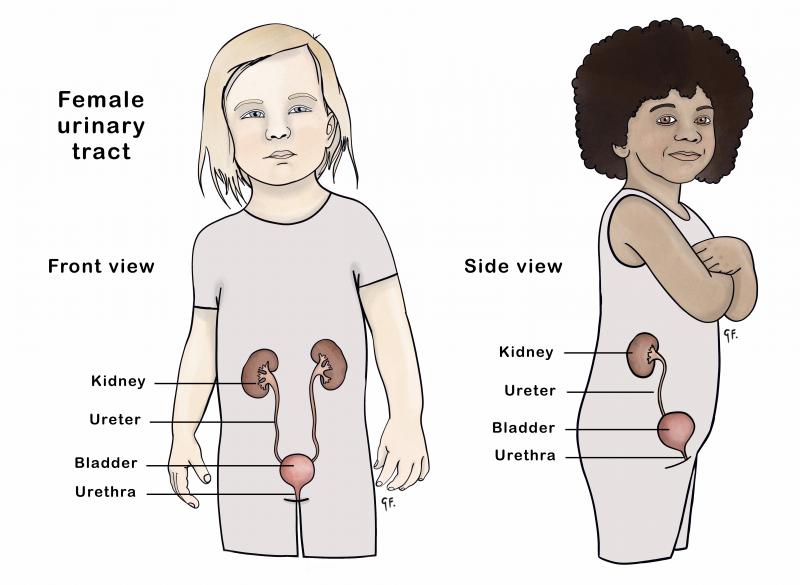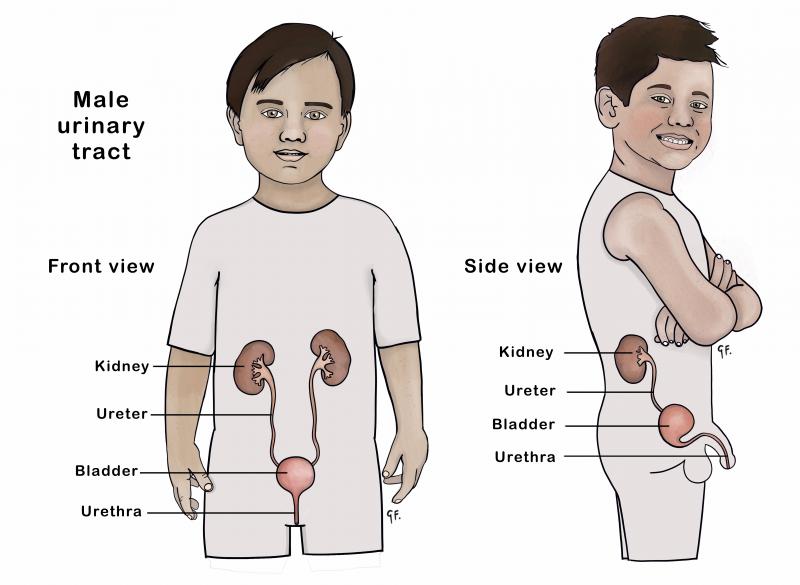Urinary Tract Infection
Urinary Tract Infection
A urinary tract infection is an infection in the wee (urine). It is a common cause of fever in young children.
Key points about urinary tract infections
- a urinary tract infection (UTI) is an infection in the urine (wee)
- UTIs are common in tamariki
- UTIs can cause tamariki to have high temperatures and become unwell
- sometimes UTIs can make pēpi and young tamariki seriously ill
- pēpi under 12 months need investigation after a UTI to see if there is anything wrong with their urinary tract
What is the urinary tract and how does it normally work?
The urinary tract is the kidneys, ureters, bladder, and urethra.
The kidneys filter and remove waste and water from the blood to produce urine. The urine travels from the kidneys down 2 narrow tubes called the ureters. The urine is then stored in the bladder.
When your child does a wee, urine flows out of the body through the urethra, a tube at the bottom of the bladder. The opening of the urethra is at the end of the penis in boys and in front of the vagina in girls.
Front and side view of the female urinary tract

Front and side view of the male urinary tract

What is a UTI?
A UTI (urinary tract infection) is an infection in the urine (wee). It usually starts in the bladder and sometimes affects the kidneys.
What causes a UTI?
A UTI usually develops when germs (bacteria) from the poo, which are on the skin, get into the urethra and into the bladder. This can happen to any baby or child and is not due to poor hygiene.
What puts my child at risk of getting a UTI?
UTIs are common. They are most common in pēpi under the age of 12 months but can affect tamariki of any age.
There are some conditions which put pēpi and tamariki at higher risk of UTIs:
- constipation
- an abnormality of the urinary tract
- neurological conditions where the bladder doesn't empty properly
What are the signs and symptoms of a UTI?
Symptoms in tamariki
Tamariki with a UTI may have the following symptoms:
- fever
- vomiting
- feeling generally unwell often with loss of appetite
- pain on doing a wee
- wanting to wee frequently (but not much wee coming out)
- pain in the lower part of the tummy or the lower back
- smelly, cloudy wee
- blood in the wee
- bedwetting or wetting during the day, if previously dry
If you think your child has a UTI, see your GP or after hours medical centre.
Symptoms in pēpi and young tamariki
Pēpi and young tamariki can't tell you about their discomfort when doing a wee and you may not notice them going more frequently. Signs of a UTI in pēpi and young tamariki can include:
- fever (with no obvious cause such as a rash or cough)
- irritability
- poor feeding
- vomiting
- being very tired and lacking energy (lethargic)
- poor weight gain
- jaundice in newborn babies which continues for more than 2 weeks
If you think your baby or child has a UTI, see your GP or after hours medical centre.
Signs of more serious infection in young pēpi and tamariki
Sometimes a simple UTI can become more serious in young pēpi or tamariki when the infection spreads to involve the kidneys, or spreads into the blood stream.
Signs of this can include:
- high fever
- not feeding
- tummy pain
- repeated vomiting
- shivering
- drowsiness
See your GP or after-hours medical centre urgently.
How is a UTI diagnosed?
Testing your child's urine is the only way to know for sure if they have a UTI. Your family doctor can arrange a urine test for your child.
Check KidsHealth's information about urine tests.
What is the treatment for a UTI?
Antibiotics
Antibiotics are the main treatment for UTIs. Treatment is usually for 3 to 7 days. This depends on several factors, including how unwell your child is and whether they have underlying kidney problems.
Your child's symptoms should start to improve after 48 hours of antibiotic treatment.
Drinking more fluids
Encouraging your child to drink more fluid may help.
Paracetamol if needed
You can give pain relief (paracetamol) if your child is in discomfort. You must follow the dosage instructions on the bottle. It is dangerous to give more than the recommended dose.
Some pēpi and tamariki need to go to hospital
The following pēpi and tamariki with a UTI usually need to go to hospital to see if they need intravenous antibiotics (given directly into a vein):
- young pēpi under 3 months of age
- tamariki who are very unwell
What other tests may be needed?
If your baby has had a UTI and is under 12 months of age, they may need further tests.
Renal ultrasound scan
The most common investigation is a renal ultrasound. This is to find out if there are any blockages and to check if the kidneys are normal in shape, size and position.
Check KidsHealth's information about renal ultrasounds.
Other investigations
A small number of pēpi and tamariki may need an MCU (micturating cysto-urethrogram) or a nuclear medicine scan.
A specialist at the hospital needs to request these tests.
Check KidsHealth's information about MCU (micturating cysto-urethrogram).
See KidsHealth's information about nuclear medicine scans.
What can I do to help prevent UTIs in my child?
Suggestions that may help some tamariki
Parents often want to know what they can do to prevent UTIs. Not all UTIs can be prevented, but here are some suggestions that may help some tamariki.
Treat any constipation
Tamariki who have constipation are at higher risk of developing a UTI.
Encourage good toilet habits
Encourage your child to go to the toilet regularly when they feel the need. Tamariki who hold on a long time are more at risk of UTIs.
Encourage your child to sit properly on the toilet with their feet on a stool so that they empty their bladder completely.
Teach girls to wipe their bottoms from front to back rather than back to front. This reduces the spread of germs from the bowel to the opening of the urethra.
Drink enough water
Make sure your child drinks plenty of water with meals, and during hot weather.
Studies of UTI in boys
There is a suggestion in studies of UTI in boys that circumcision might slightly reduce the incidence of UTI. But the benefit is small. Most specialists would not recommend circumcision for this reason unless there are repeated UTIs which are causing major health problems.
Avoiding things that may irritate your child's bottom
Try to avoid anything that may cause irritation to your child's bottom:
- avoid giving your child bubble baths, especially if they have sensitive skin
- wash your child's hair in the shower rather than in the bath so they don't sit in soapy water
- check for threadworms, which are very common in tamariki, and consider treating your child every 6 months
- encourage girls to wear cotton underwear
This page last reviewed 10 July 2023.
Do you have any feedback for KidsHealth?
If you have any feedback about the KidsHealth website, or have a suggestion for new content, please get in touch with us.
Email us now